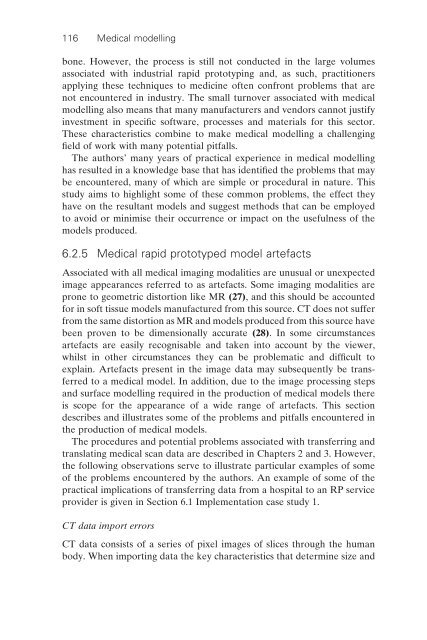R_Bibb_Medical_Modelling_The_Application_of_Adv.pdf
R_Bibb_Medical_Modelling_The_Application_of_Adv.pdf
R_Bibb_Medical_Modelling_The_Application_of_Adv.pdf
You also want an ePaper? Increase the reach of your titles
YUMPU automatically turns print PDFs into web optimized ePapers that Google loves.
116 <strong>Medical</strong> modelling<br />
bone. However, the process is still not conducted in the large volumes<br />
associated with industrial rapid prototyping and, as such, practitioners<br />
applying these techniques to medicine <strong>of</strong>ten confront problems that are<br />
not encountered in industry. <strong>The</strong> small turnover associated with medical<br />
modelling also means that many manufacturers and vendors cannot justify<br />
investment in specifi c s<strong>of</strong>tware, processes and materials for this sector.<br />
<strong>The</strong>se characteristics combine to make medical modelling a challenging<br />
fi eld <strong>of</strong> work with many potential pitfalls.<br />
<strong>The</strong> authors’ many years <strong>of</strong> practical experience in medical modelling<br />
has resulted in a knowledge base that has identifi ed the problems that may<br />
be encountered, many <strong>of</strong> which are simple or procedural in nature. This<br />
study aims to highlight some <strong>of</strong> these common problems, the effect they<br />
have on the resultant models and suggest methods that can be employed<br />
to avoid or minimise their occurrence or impact on the usefulness <strong>of</strong> the<br />
models produced.<br />
6.2.5 <strong>Medical</strong> rapid prototyped model artefacts<br />
Associated with all medical imaging modalities are unusual or unexpected<br />
image appearances referred to as artefacts. Some imaging modalities are<br />
prone to geometric distortion like MR (27), and this should be accounted<br />
for in s<strong>of</strong>t tissue models manufactured from this source. CT does not suffer<br />
from the same distortion as MR and models produced from this source have<br />
been proven to be dimensionally accurate (28). In some circumstances<br />
artefacts are easily recognisable and taken into account by the viewer,<br />
whilst in other circumstances they can be problematic and diffi cult to<br />
explain. Artefacts present in the image data may subsequently be transferred<br />
to a medical model. In addition, due to the image processing steps<br />
and surface modelling required in the production <strong>of</strong> medical models there<br />
is scope for the appearance <strong>of</strong> a wide range <strong>of</strong> artefacts. This section<br />
describes and illustrates some <strong>of</strong> the problems and pitfalls encountered in<br />
the production <strong>of</strong> medical models.<br />
<strong>The</strong> procedures and potential problems associated with transferring and<br />
translating medical scan data are described in Chapters 2 and 3. However,<br />
the following observations serve to illustrate particular examples <strong>of</strong> some<br />
<strong>of</strong> the problems encountered by the authors. An example <strong>of</strong> some <strong>of</strong> the<br />
practical implications <strong>of</strong> transferring data from a hospital to an RP service<br />
provider is given in Section 6.1 Implementation case study 1.<br />
CT data import errors<br />
CT data consists <strong>of</strong> a series <strong>of</strong> pixel images <strong>of</strong> slices through the human<br />
body. When importing data the key characteristics that determine size and
















